January 19, 2007
Air Date: January 19, 2007
FULL SHOW
SEGMENTS
Gore Hits the Global Warming Campaign Trail
/ Jeff YoungView the page for this story
Al Gore is looking to leverage the success of his film, "An Inconvenient Truth," by cloning himself. Well, not really. He's training more than a thousand people to give the slideshow presentation on global warming he gives in the movie. Living on Earth's Jeff Young sat down with Al Gore to ask him about his efforts to change the climate of public opinion. (12:00)
EU Climate Action
View the page for this story
The European Union is calling on member countries to cut their CO2 emissions 20 percent below 1990 levels, and boost renewable energy 20 percent by 2020. Host Bruce Gellerman turns to Mark Mardell, the BBC’s Europe editor, to find out what this means for energy supply, security, and future EU action on climate change. (07:00)
The Gospel of Climate Change
View the page for this story
Harvard scientists and the 30 million strong National Association of Evangelicals have joined forces and have just released an "Urgent Call to Action" to President Bush and political leaders to address global warming. Living on Earth host Bruce Gellerman speaks with Harvard biologist E.O. Wilson and Reverend Joel Hunter from Northlands Church in Orlando, Florida about the new coalition. (09:00)
Emerging Science Note/Stinky Bloom
/ Meghan VigeantView the page for this story
The rafflesia is both a flower and a parasite, with a rotting-flesh odor to boot. Meghan Vigeant reports. (01:30)
Manure Magic
/ Ashley AhearnView the page for this story
Dealing with large amounts of manure on industrial livestock farms has never been easy, environmentally sustainable, or profitable, but that's starting to change. Living on Earth's Ashley Ahearn reports on a growing industry that capitalizes on the power of cow and pig poop. (06:45)
Garbage Mountain
View the page for this story
The local dump is a place many of us visit every once in a while to throw out trash, but around the world, millions of people call it home. At Payatas, a gigantic mountain of garbage outside Manila in the Philippines, adults and children scavenge through the trash daily for treasures such as plastic and computer parts to be sold for more money than the average Filipino citizen earns. Matthew Power traveled to Payatas and wrote about it for Harper’s Magazine. He talks with host Bruce Gellerman. (10:00)
This week's EarthEar selection
listen /
download
A bubbling volcanic mud pot in Wyoming.
Show Credits and Funders
Show Transcript
HOST: Bruce Gellerman
GUESTS: Joel Hunter, Mark Mardell, Edward O. Wilson
REPORTERS: Ashley Ahearn, Jeff Young
SCIENCE NOTE: Meghan Vigeant
[THEME]
GELLERMAN: From Public Radio International - this is Living on Earth.
[THEME]
GELLERMAN: I’m Bruce Gellerman. The Climate is changing and so are attitudes. Among politicians Al Gore leads the charge. He’s training others to preach the gospel of global warming.
GORE: I’m involved in a different kind of campaign. It’s an effort to try to persuade people about why and how we must rise to the challenge, the most serious challenge our civilization has ever faced.
GELLERMAN: Also scientists and evangelical Christians put aside theories and theology, joining forces to raise awareness about climate change.
WILSON: It’s not so important where the creation comes from where earth’s vanishing bio-diversity came from, as it is now to get together to save it.
GELLERMAN: These stories and more this week on Living on Earth, stick around.
[NPR NEWSCAST]
ANNOUNCER: Support for Living on Earth comes from the National Science Foundation and Stonyfield Farm.
[THEME MUSIC]
Gore Hits the Global Warming Campaign Trail
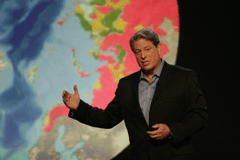
Al Gore in "An Inconvenient Truth" (Photo: Eric Lee, Copyright © 2006 by Paramount Classics)
GELLERMAN: From the Jennifer and Ted Stanley Studios in Somerville, Massachusetts- this is Living on Earth. I’m Bruce Gellerman.
Democratic candidates are already jockeying for positions in the 2008 presidential race, but not Al Gore. He says he’s committed to a different kind of campaign, combating global climate change. Gore’s documentary film, "An Inconvenient Truth," created a sensation last year, and it may well pick up an Academy Award nomination this year. And now he’s hoping to capitalize on the movie’s momentum recruiting an army of volunteers to take the message of his film into communities around the country.
[PEOPLE MILLING AROUND A CONFERENCE ROOM]
GELLERMAN: Living on Earth’s Jeff Young recently caught up with Al Gore in Nashville, Tennessee, where the former Vice President was rallying his troops.
MAN: Ok let’s get started
[CROWD SETTLES DOWN]
YOUNG: It’s just before eight in the morning and some 200 people from around the country file into a conference room at the Hilton hotel in downtown Nashville. They’re coffeed-up and loaded down with handouts and books on climate science—oh and slides, lots of slides. They’re here to learn how to be Al Gore—or at least how to present Gore’s strangely compelling slide show on global warming.
GORE: This is gonna be the slide show pretty much as I give it. It changes and evolves over time. Unfortunately, the evidence has all pointed in the same direction.

Al Gore in "An Inconvenient Truth" (Photo: Eric Lee, Copyright © 2006 by Paramount Classics)
Just behind him, Dr. Richard Alley strokes his beard and then speaks up. Alley, a climate scientist from Penn State University, makes sure the message stays true to the science.
ALLEY: If Mr. Gore and I quibble about anything here you should recognize the science of what you have just seen is remarkably solid. We can argue around the edges of everything, but the basic message is right.
GORE: I could quibble with that but, basically, thank you.
[BIG LAUGH]
YOUNG: Alley fields a question about how long different greenhouse gases persist in the atmosphere. That leads to another question about emissions from industry versus those from agriculture.
GORE: One of the judgments I’ve made as a result of all that is that it doesn’t help us to talk too much about cow farting.
[LAUGHTER]
YOUNG: A little humor helps after hours of dire predictions of sea level rise, drought and flood. During a break, Gore sat down with me to explain why he thinks a thousand people giving a slide show can help prevent those disasters.
GORE: I’m giving them my slides so they can present them in their voices, connect them to their own passion for trying to save the global environment and the first two classes I trained have already collectively given my slide show more times as a group than I’ve been able to give it personally in 15 years. So that’s great.
YOUNG: What is it you want the people who get this message to do? What’s more important: the personal consumption choices about energy or the political choices that they might make based on, say, a candidate or platform that addresses this issue?
GORE: Well I don’t think they’re separate. When people see the reality of it and reach a conclusion that this is a moral issue and we have to change. First of all, they want to make changes in their own relationship to the problem. But when people take personal actions that leads inevitably to their desire to have changes in policies. They begin to communicate with their representatives at the local, and state, and national level. They say, look, “I’ve made these changes in my life and, you know, I want you to work for changes in policy and I think that they’re linked together.”
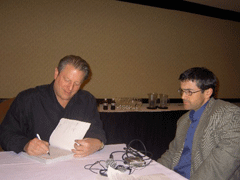
Living on Earth's Jeff Young and Al Gore.(Courtesy of Jeff Young)
YOUNG: I know at the end of the film, for example, as the credits roll there are all these things you can do—which gave it a sort of uplifting spirit. But I was wondering, ok, I can drive a hybrid car, take mass transit, use fluorescent bulbs instead of incandescent bulbs, etc, etc. What difference does it make if China is still gonna build a coal fired power plant a week?
GORE: Well, the world as a whole must respond to this and will respond to it, but it’s more likely to respond more quickly when the US provides leadership. And when enough American citizens become part of this new critical mass of opinion and the US changes policy, then it becomes much more likely that China will make the changes it has to make. And we’re all in this together.
[PEOPLE MILLING ABOUT]
YOUNG: Gore’s trainees include some top scientists and policy-makers and a smattering of celebrities. Actress Cameron Diaz was even here. But they’re not all from latte-sipping, blue-state America. There are southern accents and western boots here, too—people who can talk about global warming in places where Al Gore might not get a very warm welcome. People like Gary Dunham, a retired advertising executive from Houston.
DUNHAM: I accompanied my wife to Washington DC for a convention she is an officer in the DAR. She had a lot of busy things to do I had time on my hands and I went to see Al Gore’s movie. By the way I didn’t vote for him, I went as a skeptic. And it knocked me for a loop. I became a believer.
YOUNG: Now DAR, that’s Daughters of the American Revolution, they’re like some radical, out-there, left wing group, right?
DUNHAM: Well, no my wife would not agree with that—very patriotic group.
I actually put the program together for my wife to use with the DAR. I said honey, I’m gonna make you a program that’s gonna really get someone’s attention, and we did. And that’s where I first started giving the program, was to DAR chapters.
YOUNG: That’s right: the Daughters of the American Revolution are getting the global warming message. And so will churchgoers in Prattville, Alabama, hunters in Imperial, Pennsylvania, and—attention Wal Mart shoppers in Laramie, Wyoming—Christina Quick in eye care can also tell you about climate change.
QUICK: I’m an optician I work for Wal Mart. So this is kind of a new experience for me I’m jumping in kinda feet first. And I’m common Joe, kinda, on the street. And I think that’s a good thing because I think that I’m going to be able to go back and tell them something on a level they’ll be able to understand. So I’m excited about that.
YOUNG: And why does it matter so much to you? This has got to be not so easy, to do all this travel and take time out from your life?
QUICK: Mainly, my youngest is two years old and how can you be a good parent if you’re contemplating leaving them a world that may not be anything to look at. There might not be much left.
[AMBIENT SOUNDS FADE]
YOUNG: It’s a point Gore returns to repeatedly in our conversation—the moral aspect of climate change.
GORE: This really shouldn’t be approached as a political issue. It has political dimensions; some of the solutions require action within the political system. But ultimately it’s a moral issue, it’s an ethical issue, it’s almost a spiritual issue because it affects our survival: who are we, what is our moral responsibility to those who come after us? And the issue of how we solve it, how we can most effectively address it, we should debate that and talk about it. But what should change is the efforts of some who are intentionally trying to delay any reasoned debate by confusing the scientific evidence with, by putting out smokescreens and sort of pseudoscientific studies. I want to see the creation of a new political reality in America where the candidates in both political parties are competing among themselves to carry that mantle and to offer genuinely effective solutions. That’s really the change that’s needed.
YOUNG: If I’m a politician listening to you saying this I might say, well, why didn’t he do more when he was in office? If this was such a passionate issue for him, he had eight years as Vice President, what did he accomplish on climate change?
GORE: Well, it’s a fair question and I tried my best and I learned in the process that the opposition to the kind of dramatic changes that are needed is so deep and so ingrained that it may well be that the only way to bring about the kind of policy changes that are needed is to first of all bring about the changes in public opinion that make it possible for political leaders in both parties to do what’s necessary.
I’ll give you an example—I went to Kyoto and helped to bring about the breakthrough that achieved the treaty there. But as Vice President when I brought that treaty back home to the United States. I could only convince one senator out of 100 to ratify it, the late Paul Wellstone. And it’s not that the other senators didn’t care or weren’t intelligent, none of that. It’s just that they looked at the state of opinion in their constituencies, in their home states, and what they found was, a situation where they felt that it was sort of beyond the pale, beyond the possibility to imagine supporting something like that without suffering real electoral consequences. So one of the things I learned from that experience had to do with the need to go to the grassroots level and change public opinion to the maximum extent possible. And the good news, again is that these changes are beginning to take place. I hope they’ll be speeded up and take place in time and I believe that they will.
YOUNG: The training sessions are his effort to bring that about. But some see another possible use for this nationwide network. It’d certainly come in handy if someone wanted to, mmm, run for national political office.
[SOUNDS OF A BUSY HALLWAY]
YOUNG: Should Al Gore run for president again?
DUNHAM: God, I hope so. If I could vote twice I would.
CODY: I absolutely think he should run for president again.
FRANK: I would be ecstatic if he ran again.
GORE: It’s nice when someone says that they think that about me and I do appreciate that. But I do not have any plans or intentions or expectations of it. I’ve fallen out of love with politics. (laughs) I’m not hungering to ever be a candidate again and really do not anticipate any circumstances under which I would be. But again, I’m involved in a different kind of campaign. It’s an effort to try to persuade people about why and how, we must rise to the challenge, the most serious challenge our civilization has ever faced. And that’s the focus of my efforts.
YOUNG: This month Gore met his goal of training a thousand people to give his presentation. He leaves them with some 300 slides and a quote from Ghandi: “Become the change you wish to see in the world.”
For Living on Earth, I’m Jeff Young in Nashville.
Related links:
- **WEB EXTRA** For a longer version of the conversation between Jeff Young and Al Gore, please click here.
- The Climate Project
- Nick Seaver: Sign Up for Al Gore's Climate Project
- Andrew Dessler: Climate Change With Al Gore
[MUSIC: John Lennon “Gimme Some Truth” from ‘Imagine’ (Capitol - 1971)]
GELLERMAN: Coming up science and religion call a truce in the culture wars to avert an environmental apocalypse That’s just ahead on Living on Earth.
[MUSIC: Intelivision “Burning in Water, Drowning in Flame” from ‘Know Your Enemy: Friends of the Archenemy Record Company’ (Archenemy – 2000)
EU Climate Action
GELLERMAN: It’s Living on Earth. I’m Bruce Gellerman.
Al Gore is hardly the only major public figure devoting his energies to fighting climate change these days. In a few minutes, we’ll hear about a new collaboration between scientists and evangelical Christians on climate change.
But first, we turn to Europe, where early this spring the 27 nations of the European Union will consider an urgent call to action. The E.U.’s executive body, the European Commission, has proposed a sweeping new energy plan. It’s designed to fight climate change and reduce the region’s dependence on imported fossil fuels.
Among the goals: cutting greenhouse emissions by 20 percent below 1990 levels by the year 2020. European Union officials say if the plan is adopted it will herald a new industrial revolution and make the region the most energy efficient place on earth.
Mark Mardell is the Europe editor for the BBC. He’s on the line with us now from Brussels. Mark, from all accounts this is an awfully ambitious proposal.
MARDELL: Well, this is as you say, incredibly ambitious. Not only because of what it’s aiming for but also in its scope. There are 9 documents. They run to well over 1,000 pages and they cover anything you can possibly think of that’s to do with energy. Whether it’s to do with the way that electricity and oil companies are organized how they’re structured, down to how much electricity we should get in Europe from, whether it’s wind power or wave power or whatever, and also throwing nuclear into the bundle. So it covers everything. But until now there’s been no Europe-wide comprehensive plan.
What’s happened now is that they believe in climate change. People here are completely persuaded that climate change is a real threat. And they’re saying well, clearly this is something that we can do on a Europe-wide, global-wide scale. So that’s why they’ve got the plan.
GELLERMAN: What makes you or Europe think that they can do in 2020 what they so far haven’t been able to do by 2012- that is meet, you know, the Kyoto goals or be on target to meet those goals?
MARDELL: First of all there is an acceptance I think, in the European public that there is a problem and it has to be dealt with. It’s a very different atmosphere to America, I think. But I think the bureaucrats would also say that the technological means are there to deal with this problem. In the past I think people who said climate change had to be tackled, maybe they were thought of as people who were saying well you have to bicycle everywhere, you’ve gotta find a way of sticking a windmill in your garden and stuff like that but we can not have the sort of modern industrial society we have right now.
Now I think that is changing. There are plans, I visited the site of where the Germans are planning to build the first ever zero emission coal fired power station. There are increasing ways of using wind and wave and solar power that the EU at least sees can supply a real real big part of the energy mix. And I think nuclear is coming back into fashion a bit. It isn’t seen quite as dangerously as it once was. So I think people think this is actually technologically achievable. That they also, I must say in Europe, there’s a sort of industrial purpose. Until they are told the money is there and people are willing to spend on it then companies won’t bother to develop it. They think this will also be a sort of industrial driver for Europe.
GELLERMAN: It seems Mark, that this is not just about global climate change and green house gasses, but it’s also about energy security. The European nations are looking to the East where they get most of their energy from, Russia. And they’re saying, “Hold it, we need to become more self sufficient.”
MARDELL: That is absolutely correct. Absolutely. I mean climate change is a major driver for this. But energy security is also there in the back of everybody’s minds. Just in the way that Britain, during wartime, had to be able to supply itself with food, now some countries are saying for security reasons you’ve got to be able to supply yourself with energy. But what it also does, as you say, is make people look at Russia and wonder what can be done. You might say not very much. But certainly the diplomats of the European Union are saying, “We have to speak very loudly, very firmly with one voice.” So they want stronger negotiating parameters so that they can tell Russia, “Look don’t turn the taps off. It’s not acceptable and you in the end will suffer if you do this.”
GELLERMAN: Mark, there are 27 EU member states and they have to approve this plan in I think, was it March, what are the prospects for that?
MARDELL: I think the prospects are quite good in terms of the targets. Yes, you’re right, there are 27 countries and they’re each actually going to carry on having their own energy policy. They’re not completely pooling sovereignty. They’re not handing it over to the EU on this. They’ll continue to make their own decisions about say the exact mix between nuclear and renewables and coal. But I think there is a fairly good chance they will come to an agreement at that big meeting in March. I think where you’ll get a lot of opposition is the European Parliament and the members of the European Parliament tend to be, how shall I say? A little bit idealists, they don’t have the equivalent of an executive role. So they can afford to speak from the bully pulpit if you like. And I think a lot of them are going to say this is too little too late and they will try to get those targets raised a little bit. So they are more ambitious. There are more renewables, the aim for getting rid of carbon emissions is more ambitious.
GELLERMAN: You know, listening to you I get the sense that Europe is really entering a new era and it’s being driven by energy and climate change.
MARDELL: Yeah, it is. But I think it’s also being driven by politics. I think there is an awareness, or at least an acceptance I should say that climate change is real and it is the biggest danger facing the world in many ways. And that is a very very strong awareness in the European public. It’s almost a passion. But there’s also politics, as I say in this. The politicians in the European Union know that the EU on its 50th birthday year isn’t terribly popular. People think it spends a lot of time spending money on unnecessary things, on subsidizing farms that don’t exist, some people claim, on arguing on the minutia about whether it should have a constitution or not.
And they are looking for something that will make people say, “Ah, that’s what the EU does. That’s what it does for me. That’s why it’s worth having.” And they’ve settled on energy as that sort of policy, where they can persuade young people, young and old people, that the European Union can lead the way, show America the way. And I think that is frankly something that is popular in Europe, teaching the Americans a lesson doesn’t go down badly in most European populations. But Europe can lead the way in dealing with a very real problem.
GELLERMAN: Well, Mark thank you very much.
MARDELL: Thanks very much.
GELLERMAN: Mark Mardell is Europe Editor for the BBC in Brussels.
Related link:
European Union: Energy for a Changing World
[MUSIC: Pimmon “The Sacred Dance of Mimi Lush” from ‘Snaps Crackles Pops’ (Tiger Beat 6 – 2003)]
The Gospel of Climate Change
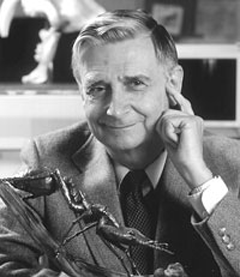
Professor E.O. Wilson (Courtesy of National Parks Service)
GELLERMAN: Here in the U.S., the climate change is creating a climate for change, among groups that have been largely on opposite sides of the political divide. Scientists and evangelical Christians tend to have very different worldviews. But the urgent challenges posed by global warming now have some of the most eminent leaders in each camp, talking and working together to save creation.
This week they announced a coalition, a new effort to convince non-believing politicians, and the public of the need to take immediate action on climate change.
Among the leaders, Harvard biologist and Pulitzer Prize-winning author Edward O. Wilson, a deeply-committed secular scientist and the Reverend Joel Hunter, the pastor of an evangelical megachurch who last year was selected president of the Christian Coalition. They both join us from Washington. And Professor Wilson, let’s start with you. What’s the goal of this collaboration?
WILSON: The goal of collaboration is to start dialogue as they say. To make friendships, to reach mutual understanding, and to recognize the common ground of concern over the environment which effects everybody the same regardless of religious belief, political orientation, or whatever. And to recognize it together as the major, very likely, the major problem facing humanity and we quickly realized that those of us from the science side, of course it’s always been the case from the religious side, that there is a term that applies here, which is the creation. We feel that it’s the obligation of the human species to save the creation which amounts to not destroying the creation anymore than we already have been. And with that kind of common goal in mind we have discovered that we could not only find close agreement on the big issues but also that we could be friends.

Professor E.O. Wilson (Courtesy of National Parks Service)
GELLERMAN: Reverend Hunter, did scientific thinking enter your mind when you where considering this?
HUNTER: Of course. Um, Christians are, don’t just keep their heads in the Bible. We believe in two books of truth. One, God wrote the Bible and the other God wrote in creation and so scientific knowledge is very important to us. And this partnership is very important also because as it says in scripture, we have an obligation to equip the saints for service. Um, and the scientists equip us with information that they have that we don’t have and we can equip them with motivated people that can make a larger impact on society. And of course the greatest benefit to this emotionally is just the friendships that we’re making and the build up of relationships because at least for Christianity our goal is love. God is love and so this has been a happy side benefit to this whole conversation and this whole project together.
GELLERMAN: But the concept and the question and the controversy over climate change has been anything but a love fest. I mean, you know that, you had to step down as the president of the Christian Coalition or at least you chose to step down over questions of climate change.
HUNTER: That’s correct. I stepped, one of the reasons that I stepped away from being the president of the Christian Coalition is because they would not prioritize very important issues like this. But if we are to mature we have to be able to form relationships with people who have differences. And so the Christian community needs to do that in order to accomplish God’s will and I think that He kinda made it like that. I think that this is part of His continuing maturing of His people.
GELLERMAN: But could this divide the congregations themselves? I mean, you’ve got Evangelical Christians who take a position very much opposite of yours.
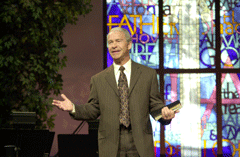
Reverend Joel Hunter a the Northland Church in Orlando, FL. (Courtesy of Northland)
GELLERMAN: Professor Wilson, you coined the term scientific humanist. I mean, you had a southern Baptist background. You forsake the faith for science and how do you reconcile the difference, that kind of leap of faith that religion requires and science; cold hard facts, things that are knowable, comprehendible, with something like religion which is exactly the opposite?
WILSON: I don’t see the need to agree on all the fundamental, the issues, including the most fundamental. It’s not so important where the creation comes from, where Earth’s vanishing biodiversity came from, as it is now to get together to save it. I’m a committed secularist and I’ve never budged from that position. I was, on the other hand, raised a southern Baptist in the Evangelical tradition, so I had a respect for it, for what it does for people, for the spiritual strength it gives them and for the passion with which they address moral issues. I could realize that even though I don’t believe in many of the tenets now there’s a huge area of overlap, of recognition and what needs to be done for humanity and therefore, grounds for collaboration at a time when it is most needed.
GELLERMAN: Can this issue of climate change, of the loss of biodiversity can it, has it become such an enormous issue that it perhaps is an epical issue, so immense that it forces us to set aside our fundamental differences and come together? Are we seeing something historic here?
WILSON: Sure is. Try once roughly every one hundred million years. That’s how often catastrophic losses of biodiversity of this nature have occurred. The last one was 65 million years ago, end of the age of dinosaurs and now that was pretty certainly due to a meteorite, giant meteorite strike. The present one, which we’re in the early stages of, unmistakably in the early stages of, to the extent that we could easily lose half of the species of plants and animals on Earth by the end of the century, is human caused. And you can’t reason with a meteorite but you certainly can reason with human beings that are causing it. Therefore, this becomes a major moral and practical, in addition to practical issue, and I think that the scientists have the role of producing the facts related to it and we hope the passion; the moral passion and dedication of the religious, the large majority of this country for example, can be brought to bear as well, and the combination of those two is what may be required; because religion and science are the two most powerful social forces in the world.
GELLERMAN: Well in the United States it seems Republicans and Democrats are pretty powerful forces as well. And I’m wondering, Reverend Hunter, does this change the climate of politics in this country?
HUNTER: Of course it will. Anytime there’s a major issue for the American public to face, politicians are going to have to determine how they’re going to come down on it. Um, and they’re going to have to determine how much emphasis they’re going to put on it. It’s yet to be seen exactly how that’s going to play out but this very definitely has political implications.
GELLERMAN: Professor Wilson, I want to thank you very much.
WILSON: Well thank you for having me.
GELLERMAN: And Reverend Hunter, thank you.
HUNTER: I’m honored to be on the program, especially with such an esteemed colleague.
GELLERMAN: Biologist Edward O. Wilson is a university professor at Harvard. The Reverend Joel Hunter is the senior pastor at the Northland Church in Orlando, Florida and a leader of the National Association of Evangelicals. They’re a part of a new effort to bring scientists and evangelical Christians together to educate Americans on the dangers of climate change.
Related links:
- Evangelical Climate Initiative
- National Association of Evangelicals
- Evangelical Environmental Network
[MUSIC: Enigma “Mea Culpa” from ‘MCMXC A.D.’ (Null - 1990)]
GELLERMAN: Just ahead on Living On Earth, turning manure into energy and money, it’s a gas! First this note on Emerging Science from Meghan Vigeant.
Emerging Science Note/Stinky Bloom

The Rafflesia arnoldii (Photo: Harry Wiriadinata and Suwito Alam)
[SWARM OF INSECTS BUZZING]
VIGEANT: Layers of blotchy red flesh lie on the forest floor. A putrid odor rises attracting swarms of carrion flies. The flies think it’s an animal carcass. But it’s not. It’s a flower.
[SCIENCE NOTE THEME]
VIGEANT: It’s called the rafflesia, and it’s the world’s biggest and smelliest flower. The bizarre plant, grows in Indonesia and instead of a sweet smell it mimics a dead animal to attract pollinating insects. It’s always been thought to be something of an orphan. But researchers writing in the journal, Science say they’ve finally found the rafflesia’s true family. And it turns out one of its closest relatives is the beloved poinsettia. They’re both members of the Euphorbiaceae- or surge- family, which also includes such familiar favorites as Irish bells and rubber trees.

The Rafflesia arnoldii (Photo: Harry Wiriadinata and Suwito Alam)
And it’s an ancient family. The rafflesia dates back to the days of the dinosaurs, making it one of the first flowers on earth.
VIGEANT: While the dinos might be gone, this beastly flower is still stinking it up.
[SNIFFS]
VIGEANT: That’s this week’s note on emerging science, I’m Meghan Vigeant.
GELLERMAN: So what do you think about our show? Does it stink? Got an idea for a story? Let us know. Our email address is comments @ l-o-e dot o-r-g that’s comments @ l-o-e.org. Our listener hotline is 800-218-9988. That’s 800-218-99-88. Or sit right down and write us a letter at: 20 Holland Street, Somerville, Massachusetts 02144. You’re listening to Living on Earth on PRI, Public Radio International.
[MUSIC: Fontanelle “Refex Vs. Parallax from ‘Fontanelle’ (Kranky- 2000)]
Manure Magic
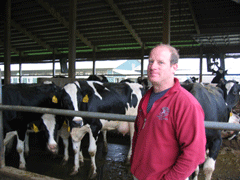
Earl Audet, co-owner of Blue Spruce Farm in Bridport, Vermont. (Photo: Ashley Ahearn)
GELLERMAN: It’s Living on Earth. I’m Bruce Gellerman. Livestock on U.S. farms produce enough manure every year to fill a convoy of trucks stretching from San Francisco to Washington, D.C. Sure it smells but the bigger problems are air and water pollution, and all the methane gas this waste releases. Methane from farms is a major contributor to global warming. But a growing number of farmers are helping to solve the problem and in the process they’re turning their animals’ manure into money.
Living on Earth’s Ashley Ahearn reports.
[LOUD COW MOOING]
AHEARN: At five o’clock on a cold Vermont morning, even the cows don’t seem too happy to be awake.
[LOUD COW MOOING]
AHEARN: Blue Spruce Dairy Farm in Bridport, Vermont, is home to 2,000 of these vocal ladies. They’re huddled together in long pens, mooing, munching hay.
[COW PEEING CLOSE BY]
AHEARN: And going to the bathroom - to the tune of 35,000 gallons of pee and manure a day. Dealing with the waste of his large herd of Holsteins used to be a heavy burden for Earl Audet, who co-owns Blue Spruce farm with his two brothers, but things have changed.
AUDET: It’s poop and pee and water, being reused.

Earl Audet, co-owner of Blue Spruce Farm in Bridport, Vermont. (Photo: Ashley Ahearn)
Walking down the long concrete aisles of one of the barns, Audet points out where the alchemy of transforming poop to power begins.
AUDET: We’ve got these alley scrapers right here that run back and forth 24 hours a day. They’re always scraping the floor, scraping the manure up, and it dumps it in the center of the barn.
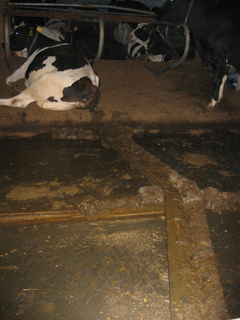
A machine scrapes the poop out from under the cows and it is piped to the digester for processing. (Photo: Ashley Ahearn)
AUDET: Yup. They just kinda step over it pretty naturally. You get some that aren’t real smart about it for a while. They’ll kinda freak out and run around.
AHEARN: From here, the manure and waste water is pumped up the hill to another noisier building, a barn-turned-power-plant.
[LOUD DIGESTER MACHINE NOISE]
AUDET: So this over here is your digester itself. It’s a concrete box, with a concrete cover. You’re standing on top of 12 feet of manure and the top two feet is where the gases rise and you capture the gases off from the top.
AHEARN: Inside this big concrete box, bacteria is eating cow manure and wastewater, and giving off methane gas, which is then burned on site in a generator to make electricity. Blue Spruce Farm used to pay 8,000 dollars a month for electricity, but that bill has disappeared. Now the power company is paying them 2,000 dollars a month for the extra power they feed back into the grid.
And there’s one more way the anaerobic digester is saving Blue Spruce Farm money every month.

The concrete digester holds 21 days worth of manure and collects the methane gas that accumulates as manure decomposes inside. (Photo: Ashley Ahearn)
AHEARN: The other byproduct of the bacteria is a fine, feathery brown substance that can be used as bedding for the cows instead of traditional wood shavings.
AUDET: It’s a lighter fluffier product and it doesn’t have those wood chips that can act like slivers. I mean, if we were laying on slivers we wouldn’t like it.
AHEARN: It’s 7,500 dollars per month in bedding Earl Audet doesn’t have to buy anymore. The digester is making it possible to look beyond the next milk check.
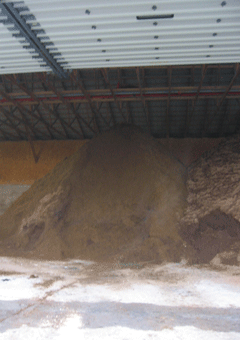
After remaining moisture is squeezed out, processed manure is re-used as bedding, saving Blue Spruce farm thousands of dollars each month. (Photo: Ashley Ahearn)
AUDET: Oh yeah. it’s all about the environmental part of it all. To begin with it’s the land management, the nutrient management, that is making it something that we have to look into as a large farm, to keep Lake Champlain cleaner, to keep the waterways cleaner.
AHEARN: When nitrogen and phosphorous-rich manure is left in ponds or spread over fields, rain carries the nutrients to nearby waterbodies, like Lake Champlain, creating dead zones where there’s not enough oxygen for marine life to survive.
There are now more than 140 dead zones worldwide, most of them the result of agricultural runoff.
That’s all in addition to livestock air emissions of ammonia and methane. Each year, manure from U.S. livestock is responsible for about two million metric tons of methane.
ROOS: And that’s about 7% of the total anthropogenic methane emissions from the United States.
AHEARN: Kurt Roos is head of the U.S. Environmental Protection Agency’s Agstar program, which encourages sustainable practices with grants to green-thinking farmers, including Earl Audet. Roos says that as the industry grows, digesters are taking a bite out of the methane emissions from livestock waste.
ROOS: I’ve been doing this a long time and we’ve seen enormous growth. When I first started this there were only like, ten systems running. It’s reduced about 70,000 metric tons already.
AHEARN: The number of anaerobic digesters has more than doubled in the last two years. Around the country, about 120 digesters produce enough electricity for 25 thousand homes.
Harnessing cow methane is a growing industry with a lot of potential, and it’s attracting a new kind of business, call them methane middlemen, cow poop capitalists: people who don’t farm – instead they buy up the rights to farmer’s manure and sell the energy.
MORALES: We will do all the engineering work, you know, scout out the location, we’ll have all the documentation in place and negotiate to sell the energy, whether that’s with the local gas or electric utility or some other end user.
AHEARN: Albert Morales is the Executive Vice President of The Environmental Power Corporation, a 60 million dollar, publicly traded company.
MORALES: Right now we’re focusing on larger scale facilities. In Texas we are developing a large scale facility that will process the manure from about 10,000 cows.
MIDKIFF: I would question whether that’s even a farm or not.
AHEARN: Ken Midkiff is the Sierra Club Conservation Chair for Missouri.
MIDKIFF: My guess is that the animals, the cows in this case, Holsteins probably, are kept on concrete where the manure and the feces and the urine are easily collected. Chances are those are going into an anaerobic.. Is that a farm? I mean, you know, Sounds like a factory to me. It sounds like an industrial process.
AHEARN: The Sierra Club opposes anything that might encourage what some call factory farms, even though the digesters lower methane emissions, and dead zone causing run-off.
A recent study by the EPA says 7,000 more farms in the U.S. could install digesters. And if they did it would reduce methane emissions by up to 70% and supply power for 630,000 more homes. Not the solution to the whole energy picture perhaps, but a big part of the cow pie.
For Living on Earth, I’m Ashley Ahearn in Bridport, Vermont.
Related links:
- U.S. EPA’s Agstar, Agriculture Renewable Energy program
- Environmental Power
- Anaerobic Digester Report by the National Renewable Energies Lab
- Central VT Public Supply’s Green Power Initiative
- Sierra Club’s Statement on Anaerobic Digesters
[MUSIC: David Ross MacDonald “`Til I’m Gone” from ‘Knuckled Brass and Bone’ (Pepper Tree Records – 2006)]
Garbage Mountain
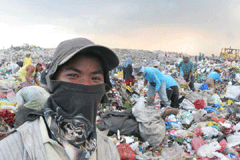
A mangangalahig, or scavenger, atop the 130-foot high garbage mountain at the Payatas Dump, Quezon City, Philippines. (Photo: (c) Matthew Power, 2006)
GELLERMAN: For most of us, “out of sight, out of mind,” toss it away and it’s gone. But imagine what really happens to all that trash the world throws away.
POWER: As we come over a rise my first glimpse of Payatas is hallucinatory, a great grey smoky mass that towers above the trees and shanties creeping up to its edge. On the rounded summit a tiny backhoe crawls along a contour seeming to float in the sky.
GELLERMAN: That’s Matthew Power writing about a place called Payatas. It’s just outside Manila, the capital city of the Philippines it’s a gargantuan mountain of garbage.

Matthew Power ((c) Matthew Power, 2006)
GELLERMAN: Matthew Power is a contributing editor at Harper’s Magazine and his recent article “The Magic Mountain: Trickle-Down Economics in a Philippine Garbage Dump” is a riveting journey into a world that few of us can imagine, but that millions of people actually inhabit. It’s the world of garbage pickers people who make their living scouring through the refuse of their countrymen. The residents of Payatas, says Matthew Power, are much like those in shantytowns throughout the developing world.
POWER: Largely they’re people that have migrated from other parts of the Philippines, the sort of rural hinterlands of the Philippine island group, are incredibly poor so a lot of people from the country side, and this is a global phenomenon, a lot of people from the Philippine country side have moved to the boundaries and the perimeters of the larger urban areas. And one of the most plausible means of making a living that they found is to work these enormous garbage dumps.

A mangangalahig, or scavenger, atop the 130-foot high garbage mountain at the Payatas Dump, Quezon City, Philippines. ((c) Matthew Power, 2006)
POWER: In a lot of ways. You can actually make in a given day, they’re called mangangalahigs, that’s the word in Philippino. Um, on a given day you can make about twice the national mean income by scavenging through the trash for recyclables.
GELLERMAN: But they don’t only work on this dump they live next to it.
POWER: Yeah, there is a large shanty town that’s been built up around it and that was actually the reason I first went to Payatas was because of this disaster that happened in 2000, was a section of the dump collapsed and killed 300 people in one of the shanty towns that had been built up on the edge of the dump
GELLERMAN: This mountain of garbage at Payatas must be incredibly toxic the way you describe it, this stuff oozing out of the ground?
POWER: Yeah, it’s a real problem. I mean one of the things is because Payatas originally, 30 years ago, was started as an illegal dump site it was essentially just a ravine that people started dumping garbage in and it metastasized into this enormous mountain of garbage. So it’s never had a liner like a proper garbage dump is supposed to have to keep all the leachate, which is this chemical distillate of all the different things that are in the garbage, from leaking out. So you have this problem that just spreads out into the waterways and flows directly into the Pasig river, which is the main sort of waterway that runs through metro Manila.

A polluted tributary of the Pasig River, below the Payatas dump, in which boys wash plastic bags for recycling. ((c) Matthew Power, 2006)
GELLERMAN: What did it smell like, this mountain of trash?
POWER: It’s funny, you actually begin to get acclimatized to it relatively fast. I mean It smells terrible, as you can imagine. You’re in the tropics so it’s very humid. It rains a lot. And you’re standing on a 150 foot high pile of putrescent garbage. You know there’s food rotting. There’s a lot of burning, um so there’s a lot of plastic burnt smoke in the air, which is also incredibly toxic. It’s filled with dioxin. So it smells terrible. I think if you, you know if you left your garbage out in the sun for a week and then stuck your head inside the bag you’d get a good sense. But by the same token you actually kind of get used to it after a few days.
GELLERMAN: You write about Manila being this sprawling megalopolis. That’s dumping 7,000 tons of debris every day in these dumps. And that this is not unique to Manila. That this is a global problem.
POWER: Yeah, that’s a global phenomenon. At the beginning of the industrial revolution two percent of the world lived in cities. And this year it’s going to be 50 percent and the estimate is by 2050, actually 80 percent of the world will live in these urban areas, and half of that will be slums. Slums like Payatas and Lagos, Nigeria, Mexico City, Cairo, Mumbai, which I lived in India for a year, and there’s a slum on the outskirts of Mumbai called Darvie, which has a million people living in a square mile.

Child scavengers at Pier 18, Manila ((c) Matthew Power, 2006)
POWER: Ah yeah, well I spoke to one sociologist who had done an extensive study on the scavengers in Manila and the statistic he came up with was that they were actually pulling 25 percent of the daily house hold waste out of the waste stream and into recycling. So they’re actually serving an incredibly important economic ecological niche. They’re, you know, taking almost all the usable plastics all the usable metals. They were pulling out parts of computers and reusing them; there’s a whole mini industry of recycling Pentium chips and printer cartridges. Which printer cartridges are like the diamonds that are scattered about inside this garbage. Like if you find one that’s the best day because you can sell them for something on the order of five or six dollars a piece.
GELLERMAN: And that represents what percentage of their daily income?
POWER: Oh, that’d be about twice what you would make on a normal day.
GELLERMAN: So these people are like bottom feeders in a sense. They’re serving a social function. And if they close these dumps or put them off limits to these scavengers what would happen to them? And, I guess, what would happen to us?
POWER: One of the problems when they closed Payatas for a few months was that garbage piled up all over the city. They simply didn’t have anywhere else to bring it. If you put these dumps further out in the countryside the scavenger community will follow the garbage. It’s like a gold rush. They’ll follow it wherever it goes. So the society is pretty resilient. And they’re very good at figuring out what they can do to survive. Which is a phenomenon that’s kind of across the entire ecology of slums all over the world. I mean there’s this tendency to turn them into these UNICEF posters of something to be pitied. What I came away from there with was this real sense of human endurance and the ability to survive and still lead a happy life.
I’m not saying that they shouldn’t have the opportunities to make things better for themselves but I think that by just pitying them you deny them this sort of agency to make something of their lives. And when they’re allowed to sort of organize themselves and help with organizing themselves they actually can do really amazing things and be a big part of you know an ecological mentality. You know, a lot of them are starting to see themselves as recyclers and as understanding that they’re doing a good thing, which empowers them to demand better standards of living for themselves.

An 8 year old boy scavenger at Pier 18, a waste transfer station on the Manila waterfront. ((c) Matthew Power, 2006)
GELLERMAN: Matthew Power is a contributing editor to Harper’s Magazine. His article, The Magic Mountain appears in a recent issue of the magazine. Matthew, thank you very much.
POWER: Thank you.
Related links:
- “The Magic Mountain: Trickle Down Economics in a Philippine Garbage Dump”
- Matthew Power’s article appears in the December 2006 issue of Harper’s Magazine
[MUSIC: TV On The Radio “Dirty Whirl” from ‘Return To Cookie Mountain’ (Touch & Go Records – 2006)]
GELLERMAN: Next week on Living on Earth, an Australian court says coal companies must consider climate change in their production plans. Industry officials say the ruling puts the whole country between a rock and a hard place.
WILLIAMS: All of our activities, all of our businesses produce greenhouse gases, so where do you draw the line? Is it just coal exports or are we going right down the chain to the building of your suburban home?
GELLERMAN: The next installment of our series, “Generating Controversy; the Changing Climate of Coal,” next week on Living on Earth.
[GEYSER BUBBLING: “Artist Paint Pot Mud Cauldron” recorded by John R. Benham for “Yellowstone National Park: An Audio Tour of Discovery” (Benham Audiophile Recordings – 2004)]
GELLERMAN: Double Double toil and trouble. We leave you this week with some mud cauldron bubbles. In Yellowstone National Park’s geothermally over-active landscape, volcanic mud pots put on quite a spectacle as they stew their soupy goup at a temperature close to 200 degrees Fahrenheit. John R. Benham recorded the glurps, gloops, and glubs of this bubbly boiler in Mammoth, Wyoming. It’s known as the Artist’s Paint Pot.
Living on Earth is produced by the World Media Foundation. Our crew includes Ashley Ahearn, Eileen Bolinsky, Ian Gray, Ingrid Lobet, Emily Taylor, Peter Thomson and Jeff Young - with help from Bobby Bascomb, and Kelley Cronin. Our interns are Paige Doughty and Meghan Vigeant. Dennis Foley is our technical director. Our executive producer is Steve Curwood. Alison Lirish Dean composed our themes. You can find us at loe dot org. I’m Bruce Gellerman. Whoops! Excuse me. Thanks for listening.
ANNOUNCER: Funding for Living on Earth comes from the National Science Foundation, supporting coverage of emerging science; And Stonyfield Farm Organic yogurt, smoothies and milk. Ten percent of profits are donated to efforts that help protect and restore the earth. Details at Stonyfield dot com.
Support also comes from you our listeners, the Ford Foundation, the Park Foundation and the Saunders Hotel Group of Boston’s Lennox and Copley Square Hotels. Serving you and the environment while helping preserve the past and protect the future, 800-225-7676.
ANNOUNCER2: You’re listening to PRI, Public Radio International.
Living on Earth wants to hear from you!
Living on Earth
62 Calef Highway, Suite 212
Lee, NH 03861
Telephone: 617-287-4121
E-mail: comments@loe.org
Newsletter [Click here]
Donate to Living on Earth!
Living on Earth is an independent media program and relies entirely on contributions from listeners and institutions supporting public service. Please donate now to preserve an independent environmental voice.
NewsletterLiving on Earth offers a weekly delivery of the show's rundown to your mailbox. Sign up for our newsletter today!
 Sailors For The Sea: Be the change you want to sea.
Sailors For The Sea: Be the change you want to sea.
 The Grantham Foundation for the Protection of the Environment: Committed to protecting and improving the health of the global environment.
The Grantham Foundation for the Protection of the Environment: Committed to protecting and improving the health of the global environment.
 Contribute to Living on Earth and receive, as our gift to you, an archival print of one of Mark Seth Lender's extraordinary wildlife photographs. Follow the link to see Mark's current collection of photographs.
Contribute to Living on Earth and receive, as our gift to you, an archival print of one of Mark Seth Lender's extraordinary wildlife photographs. Follow the link to see Mark's current collection of photographs.
 Buy a signed copy of Mark Seth Lender's book Smeagull the Seagull & support Living on Earth
Buy a signed copy of Mark Seth Lender's book Smeagull the Seagull & support Living on Earth

